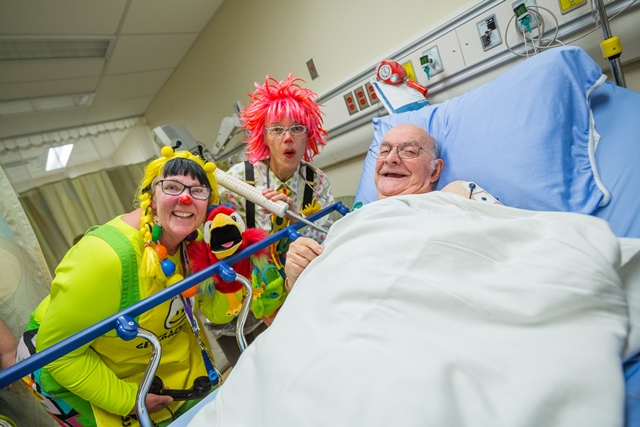In a children’s hospital, you don’t have to look far to discover activities and entertainment. But for adults staying in the hospital, it can be harder to find distractions from procedures, tests, and waiting. Enter Dottie and Polly, a pair of jokesters on a mission to spread warmth and laughter in the hospital.
They say laughter is the best medicine. That’s why a visit from Hamilton Health Sciences’ (HHS) therapeutic hospital clowns can make our patients feel just a bit better. Developed in 2002, the care clown program aims to bring warmth and happiness to patients, families and health care providers at Hamilton General Hospital.
“Children receive so much attention and stimulation as an inpatient to while away their time. Adults, on the other hand, must find ways to make their stay bearable, and so began the humour cart and therapeutic care clown program,” says Lorraine McGrattan, manager of Volunteer Resources, who believes the program’s impact on patients, visitors, and staff is immeasurable. Laughter is known to decrease stress and relax the body, triggering the release of endorphins, the chemical that makes you feel happy.
Dressed in bright colours and armed with compassion, care clowns Dottie and Polly Pigtails visit Hamilton General Hospital about twice a month. They carry props like stuffed flowers to bring spring fever into the hospital room, oversized scissors for pretend haircuts and manicures, “boo boo” stickers to place on hurt areas, and a giant needle during flu season to administer the “flu shot.”
Dottie says there is nothing more rewarding than seeing a sad face turn happy. “The reactions are almost always positive. People tell me I made their day just by walking through the halls, even when I haven’t said anything yet.” Suited in her funky polka dot attire and bright pink hair, one of her favourite things to do is to sing, which usually gets the patient joining in. She sings popular songs like “You are my sunshine” during a patient’s stay and “Hit the road, Jack” upon discharge.
Dottie has been volunteering with HHS since 2013, while Polly, a former HHS Pharmacy Technician, has been volunteering since 2006. Polly recounts standout moments as a care clown, like when she was invited into a room when an agitated patient had to be transferred to another hospital by paramedics. “The patient happily transferred to the stretcher. We waved and sang goodbye. His wife was so very grateful. One year later we met her, and she reminded us of the stressful moment and her heart felt gratitude.”
Polly says it’s a gift to raise people’s spirits and help them smile, even through the most trying times. Quiet waiting rooms transform and fill with laughter and conversation when they drop by. “We feel truly blessed to have shared this moment with them. Laughter does help heal and is a definite stress buster for patients, staff and visitors.”
But between stickers and songs, their best trick of all is simply their caring personalities. “These two ladies are beautiful inside and out. I love watching the reactions they get as they walk through the halls,” says Nancy Hayes, coordinator for the Volunteer Resources department.
Volunteer resources organizes volunteers across HHS hospitals, including those who dedicate their time to helping visitors find their way around (known as our GPS – Guiding People Services), those who work in the gift shops, and other positions like care clowns.
On a recruitment poster that hangs in the Volunteer Resources office is a quote from Patch Adams (you may be familiar with the physician that used humour to treat patients from the 1998 comedy starring Robin Williams).
The poster reads: “It’s fun to do and a jubilant thrill to help others.”
“It is certainly inspirational,” says Polly.
This article was submitted by Hamilton Health Sciences.


